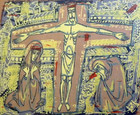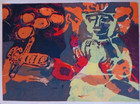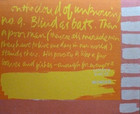Sister Mary Corita Kent
(1918-1986)
Sister Mary Corita Kent was the perfect embodiment of the New Nun, whose life, faith, and art reflected the reforming spirit of the Second Vatican Council, convened in the early 1960s to guide the Roman Catholic Church into the modern era. During a period of turbulent social change, she found a way to be in the world but not of the world, engaging divisive social and moral issues of her day like the Civil Rights Movement and the War in Vietnam through the medium of faith-inspired printmaking. The artist-nun combined the contemporary graphic design of billboards, product packaging, and protest placards with the words of poetry, advertising jingles, the Beatles, and the Bible to create brightly-colored, pop-art prints, proclaiming a message of love, peace, and social justice. It proved to be an explosion of creative energy, which could not be contained in the strict confines of a religious order.
Born Frances Elizabeth Kent in Dodge City, Iowa, the artist entered the Order of the Immaculate Heart of Mary in Los Angeles, aged 18, taking the name of Sister Mary Corita. After graduating from Immaculate Heart College in 1941, she taught elementary school in British Columbia, returning to her alma mater five years later to join the faculty of the art department. Sister Mary Corita spent the next two decades there as a teacher in tune with changing times. She involved her students in creating disposable public art installations from cardboard boxes and turned the college's staid Mary's Day procession into a 1960s culture "happening." Between semesters in the month of August, the artist-nun devoted herself fulltime to making silk-screen, serigraph prints, the versatile medium she had chosen to produce multiple images at a lower cost. Sister Mary Corita Kent created over 800 graphic designs during her lifetime, moving away from specifically religious imagery toward text-oriented, pop art.
Sister Mary Corita’s first prints from the 1950s present traditional religious subjects in an abstract figurative style, coming out of her work with medieval sculpture as a graduate student at the University of Southern California. A good example in the Sacred Art Pilgrim Collection is Christ Suffering Over Jerusalem (1951). Text is already present in Christ and Mary (1954), where script functions as a key visual element in this Cubist variation on an illuminated manuscript page. Guardian Angel (1955) and Nativity (1956) also depict two time-honored sacred themes in a "neo-Gothic" idiom, while Sea of Galilee (1960) suggests oriental graphic design in its repeated use of decorative motifs and its emphasis on negative space. This was cutting-edged religious art in the American Catholic Church of the 1950s. The new openness in the Vatican in the following decade encouraged Sister Mary Corita to go further afield and seek inspiration in popular American culture.
Three months before Pope John XXIII opened the Second Vatican Council in Rome in October 1962, a commercial illustrator named Andy Warhol took the art scene by storm with his 32 Campbell’s Soup Cans installation in a Los Angeles gallery, transforming the humble soup can label overnight into an icon of modern art. In prints from the 1960s, Sister Mary Corita eagerly embraced the new pop art style, seeing, as she put it, “signs as signs.” Moving away from figurative to textual art, she delighted in uncovering spiritual double meanings in product labels like Wonder Bread, which suggested the Eucharist. The Sunkist citrus fruit logo was the inspiration for the serigraph, As Witnesses to the Light, in homage to Pope John and John F. Kennedy, where the text reads: “Two men called John were sent by God.” In a 1968 essay, the artist-nun even provided a line by line spiritual explication of a Hunt’s tomato catsup advertisement!
Sister Mary Corita often mixed and matched words and quotations in provocative ways to tease out new truths. In the serigraph, Love is Here to Stay (1965), hand-lettered lyrics from the Beatles' song,"Things We Said Today," appear under the eye-catching Look magazine logo. Two years later, she borrowed from the Beatles again for the serigraph, Jesus Never Fails, where the line, “I get by with a little help from my friends” is juxtaposed with the much-loved hymn refrain of the title. Sometimes, the artist-nun simply scrawled quotable quotes across a background of multi-colored abstract shapes. One example in the Sacred Art Pilgrim Collection is Enough for Everyone (1965), a tangerine-and-pink toned serigraph with text from Activist American Priest Daniel Berrigan. It was all part of what the printmaker’s friend, Protestant Theologian Harvey Cox, called her “festive involvement with the world.”
The conservative Catholic Archdiocese in Los Angeles took a different view of what Sister Mary Corita's detractors called her “strange and weird” imagery. Cardinal James Francis MacIntyre was particularly incensed at the 1964 serigraph, The Juiciest Tomato of them All, where this paraphrase of a Del Monte product slogan was used in praise of the Virgin Mary. He banned the image from public display. In 1968, Sister Mary Corita left the Immaculate Heart of Mary Order to devote herself fulltime to art making. Two years later, some 90% of the sisters asked for the dispensation of their vows rather than submit to an archdiocesan ultimatum to rein in proposed reforms. The dissident nuns set up the Immaculate Heart Community, an independent, ecumenical group, now affiliated with the Corita Art Center, a gallery-archive promoting the art and the educational programs of Sister Mary Corita Kent.
The former Sister Mary Corita assumed the name, Corita Kent, and settled in Boston. During this time of transition, she created the "Heroes and Sheroes" series of documentary-styled prints in psychedelic colors, recombining texts and images from the mass media to comment on current events. In Pieta 1969, a statement from Rose Kennedy about the 1968 assassination of her son, Bobby, (accompanied by a lengthy student commentary on those words) appear under a purple and orange colored icon of the Lamentation of Christ. Kent continued to make art supporting Latino Labor Activist Cesar Chavez, the 1972 Democratic Presidential Candidate George McGovern, and other liberal causes close to her heart, but much of her time out in the secular world was taken up with commercial commisions for magazine covers, greeting cards, wrapping paper designs, and an ad campaign for Group W (the Westinghouse Broadcasting Company).
The art of Corita Kent often suffers by comparison with Sister Mary Corita's stylish, experimental graphic pieces from the 1960s, but whether inside or outside the church, she never seemed to be far from controversy. When Kent created the now famous Rainbow Swash design for a 140-ft. high Boston Gas Company storage tank, visible from the city’s Southeast Expressway, critics were quick to claim the peace activist artist had incorporated a profile of Vietnamese Leader Ho Chi Minh into its blue stripe. Kent completed her last “public works” project a year before her death from cancer in 1986. It was a stamp design for the U.S. Postal Service with another rainbow swash and the single word: LOVE.
Texts in Sister Mary Corita Kent serigraphs:
Christ and Mary (1954): Sacred Heart of Jesus, May Mary’s Heart Immaculate be forever praised. I place my trust in thee. I will bless every home where an image of my heart shall be honored.
Enough for Everyone (1965) On the Cloud of Unknowing no. 9. Blind as bats. Then a poor man (they are all miracle men, they have to live one day in our world) stands there. His poverty is like a few loaves and fishes--enough for everyone. (Daniel Berrigan)
Pieta 1969 (1969) We shall know him not with useless mourning and vain regrets for the past, but with firm and indomitable resolutions for the future: acting now to relieve the starvation of people in this country, working now to aid the disadvantaged and those helpless, inarticulate masses for whom he worked long hours, night as well as day (Rose Kennedy)…It’s me again. I’ve learned a really great thing. It’s something you told me before, but I couldn’t really feel that way then. But tonight I was listening to Sen. Kennedy’s mother on TV, and she was talking about her son’s love of living, but it was in such a great human way, so unpretentious that it helped me see that one of the great qualities of the Kennedys was that they were so reachable. In the middle of destruction was this great creative force always there and always an honest statement of a really human responsive entity who wasn’t hiding behind a bureaucracy or a static position. Then I started thinking about how many times I walk around and people talk to me, but I am not there. I’m not honestly responding. I want to try to develop some of the Kennedy quality. It is so easy to fall apart when surrounded by destruction. Now I can see what you meant when you said we have to create. It’s the only thing we can do. I read a book, The Spinster, by Silvia Baton Warner. You’re probably familiar with it. What impressed me so much about it was that Sylvia helped the children find channels to express their aggressions in a creative rather than a destructive way. That’s what we have to do. We have to revolutionize the dead lump called the present educational system from Dick & Jane into an alive process not a product. And help other people learn to be creative rather than destructive. With this we could change the world. One person can do a lot. Two people can do even more. Since I listened to Mrs. Kennedy I have faith. This in the first time for many years that I really do have faith. Now when I consider and feel what have been mere words that once seemed idiotically ideal and illusory--faith, hope, and charity--these words become my essence. They become the whole. When life is so absurd you have to make a choice about living--yes or no--and if it’s no, then, end your life, but if it is yes, throw yourself right into it and say yes to every second and yes to any one second is yes to the whole of existence. This is what you and Mrs. Kennedy have helped me learn. Love, (A student)

Christ Suffering Over Jerusalem (1951)

Christ and Mary (1954)

Guardian Angel

Nativity (1956)

St. Thomas a Becket (1957)

She Brought Forth a Son (1958)

Sea of Galilee (1960)

Enough for Everyone (1965)

Pieta 1969

Sacred Heart

Wonderbread (1962)

As Witness to the Light (1964)

Love is Here to Stay

